29 novembre 2019 vendredi
42 degrees, Rain
3 mph, E wind
The inundated year of the Illinois Country. The annual summary of the Fort’s jardin must reflect a very perplexing and diminished garden year in the Illinois Country. This jardin potager accounting rambles a bit through time and space, thus I am begging your indulgence. The Fort garden summary echoes other garden reports across the region that recount early shortened growing seasons due to cool temperatures and persistent rain followed by flooding rains and rising creek and river surges to be followed by mid-to-late heat and dryness in the autumn. The year’s conclusion is now fast approaching, hastened by recent rains and a snow accompanied by record-setting frigid temperatures. Such weather extremes is nothing new in our region as historically Le Pays des Illinois has both suffered and benefited from its location near the powerful Mississippi River and the nearby confluences of the great Missouri and Ohio Rivers. This year was one of challenge. To the plus, river flooding creates fertile alluvial bottomland soil resulting in the successful crops grown there throughout centuries. Bountiful harvests grown in this rich soil are transported along these super waterways feeding this continent and beyond. To the negative, the risk of living so close to such immense power is the exposure to the mighty Mississippi and the region’s other large rivers’ periodic flooding due to extreme weather conditions in the middle of North America. The excess water from these floods spills across fields, homes, and farmland and is drawn downward following the continental watery path to the Gulf of Mexico. Author M. J. Morgan, in his 2010 publication Land of Big Rivers: French and Indian Illinois, 1699-1778, gives an account of these floods during the French Colonial era:
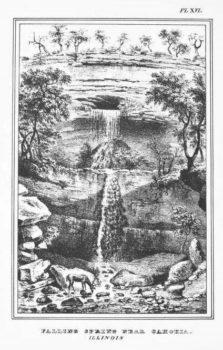
Falling Spring Near Cahokia, Illinois by J.C. Wild, published 1842
“The major floods of the Mississippi, those inundated years of 1725, 1772, and 1785, are dramatically recorded. The flood of 1785, remembered by many French and Americans alike as the “greatest of the last century,” forced the French of Kaskaskia and Cahokia up to bluffs and swept away the western walls of stone Fort Chartres near Prairie du Rocher. To the French, 1785 was the Year of the Great Waters. Accounts abound of George Rogers Clark’s 1779 march to Vincennes, when he and his men waded thigh, waist, and shoulder-deep in icy water much of the way. Yet little appears in routine military and political correspondence about the daily role of water in this common riverine world. The action of the Mississippi, fed not only the swollen tributary flow from the Missouri but by consistent hydrologic cycles of rains and waterfalls, routinely affected the lives of humans. In 1765, for instance, notarial records for Kaskaskia list an auction of a house and lot at New Chartres, soon to be washed away by the Mississippi.”*
After the prolonged absence from the Fort during the flooding emergency of late winter through mid-summer, the return to the garden in late July after a five-week lapse was made with some fear of the garden’s soggy condition. Weeds grew large and with abandon in the raised beds in their determined effort to create a garden coup. Delightfully, there was still beauty to be discovered in the jardin’s flowers blooming uninhibitedly throughout the same raised beds. Much work was needed to push back the garden’s wildness but this gardener was simply grateful that the jardin remained whole and intact. The garden is supported solely by this gardener and outside funding. Any damage caused by flooding would be a severe set-back and difficult to impossible to repair. So this gratefulness came with the full realization that it could have been so much worse. Our hearts go out to those not so fortunate and whose homes and lives were uprooted and devastated by the floodwaters. A sincere thank you to all of those who worked so hard to protect the area and the Fort site from further harm; thank you to federal, state, and local governments and agencies, along with area residents and businesses for their hard work protecting this historic area and the levee districts in the region.
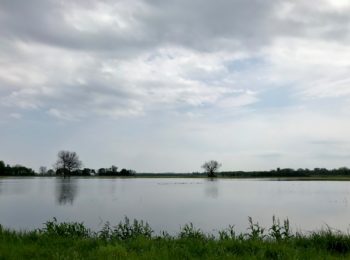
April 2019 flooding (CK)
Returning to the site after the reopening of the Prairie du Rocher flood gates, the jardin welcomed us in its flowery and weed-filled wildness to a bountiful crop of heirloom beets and carrots, the seeds were sown late winter just as the rains began in earnest. Garden volunteers Sabre Deterding and George Kuttererer, along with site staff Tim Helms, assisted in clearing the overgrown raised beds of their weeds and the expired spring crops over the following late summer months. August and September proved to be contrarily dry with much heat and the work of watering the remaining plantings was essential, performed in tandem with the weeding efforts. The espaliered heritage apple trees needed severe pruning to return to form as the saturated ground encouraged excessive growth and no fruit. The area of the large melon bed beyond the fruit trees became totally overgrown with the levee’s Bermuda grass and will require much effort in the new year to recover from its current condition.
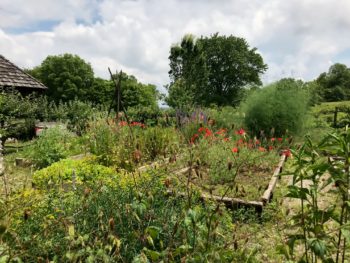
Garden run amok, early June 2019 (CK)
While the garden was in stasis over the summer, it allowed time and effort to be spent creating two new garden bed projects in Prairie du Rocher. These new garden endeavors helped this impatient and anxious gardener to continue the Illinois Country’s heritage garden journey during and despite the lack of access to the Fort’s jardin potager. The new Creole House Herb Bed and Prairie du Rocher Village Hall beds were planted and grew strong and true over the summer on the other side of the Prairie du Rocher flood gates-celebrating the rich heritage of this Illinois Country historic community’s fast approaching 300th anniversary. The Fort jardin potager project is proud to support these Prairie du Rocher heritage garden efforts with seeds and plants from the Fort garden. Thank you to Colleen Schilling at the Creole House for her hard work in the site’s new herb bed and many thanks to the Village of Prairie du Rocher for buying new plants for their beds and their village workers for assisting in the upkeep of their newly planted beds throughout the summer. If anyone would like to volunteer for these two new projects in Prairie du Rocher in 2020, please reach out to heritage@fdcjardin.com.
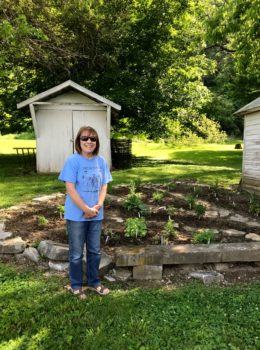
Colleen Schilling, Creole House Herb Garden 2019
Over these same summer months, other garden opportunities arose to promote the deep French Colonial Illinois Country garden history. It was wonderful to be invited to speak at the annual Foundation for Restoration of Ste. Genevieve’s Fall History Conference in September and again at the Randolph County Retired Teachers Association in Chester mid-October. Earlier in the summer, a Fort de Chartres Heritage Garden presentation was given to the Jefferson County Master Gardener’s Chapter in Hillsboro, MO. It is always special sharing information and meeting with interested individuals and groups about our French Colonial garden history. The text of my Ste. Genevieve’s Fall History Conference’s presentation can be found at this link: French Colonial Kitchen Gardens of North America and the Illinois Country. Sincere thanks is offered to these organizations for being amenable to time travel the region’s French Colonial past and for being willing to examine its history through the path of its foodways.
It is hard to believe that November is at an end and we are at the conclusion of this water saturated garden year. As we enter December, the last of the remaining weeds are being cleared from the garden’s raised beds and then the beds are being amended with leave litter and compost, preparing for the new season ahead. Historically late autumn harvests signal the traditional end of the current garden season and the beginning of the next. The simple jardin tasks of clearing and amending raised beds and planning for the new season ahead help to restore the balance in our garden life, creating room in our garden dreams to imagine the promise of the upcoming New Year. De beaux rêves!
To continue to follow this jardin’s journey, please visit Fort de Chartres Jardin Potager’s Facebook page at www.facebook.com/fdcjardin.
* “Sale at public auction of a house and 2 arpent lot at New Chartres, soon to be washed away by the Mississippi, done at the request of Clement Delor, heir of the late Magdelaine de Portneuf and of Carpentier, acting as guardian of Jean Jacques Coulon de Villiers, in the absence of De Villiers. Adjudged to Bizette, trader, for 350 livres. Executed at New Chartres.”
Dean, Lawrie Cena and Margaret Kimball Brown. 1984. The Kaskaskia Manuscripts: 1708–1816. Springfield, IL: Illinois State Archives. 65:6:29:1
J. C. Wild Illustrations. 1842. The valley of the Mississippi illustrated in a series of views.
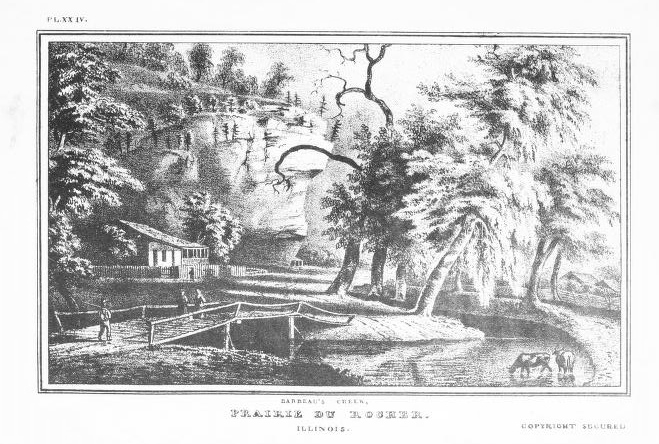
Barbeau’s Creek, Prairie du Rocher, Illinois. J. C. Wild, 1842
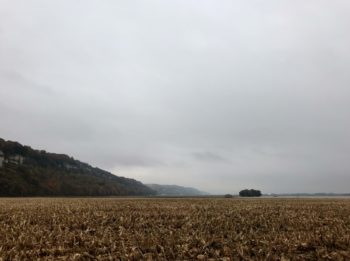
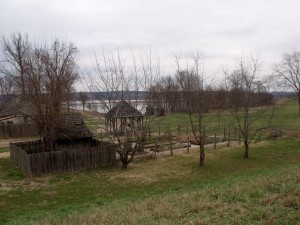

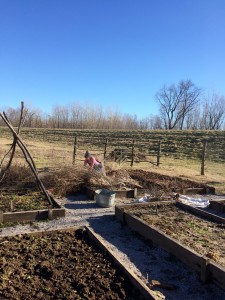
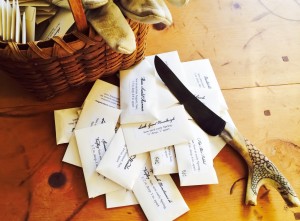
Recent Comments